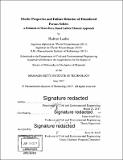| dc.contributor.advisor | Franz-Josef Ulm. | en_US |
| dc.contributor.author | Laubie, Hadrien Hyacinthe | en_US |
| dc.contributor.other | Massachusetts Institute of Technology. Department of Civil and Environmental Engineering. | en_US |
| dc.date.accessioned | 2017-09-15T15:34:25Z | |
| dc.date.available | 2017-09-15T15:34:25Z | |
| dc.date.copyright | 2017 | en_US |
| dc.date.issued | 2017 | en_US |
| dc.identifier.uri | http://hdl.handle.net/1721.1/111443 | |
| dc.description | Thesis: Ph. D. in Mechanics of Materials, Massachusetts Institute of Technology, Department of Civil and Environmental Engineering, 2017. | en_US |
| dc.description | Cataloged from PDF version of thesis. | en_US |
| dc.description | Includes bibliographical references (pages 165-175). | en_US |
| dc.description.abstract | The effective mechanical properties of multiphase materials not only depend on the volume fraction and chemical composition of their constituents but also on details of their local texture. Yet, most homogenization methods do not take this texture effect into account. Understanding how local texture affects the overall elastic and failure properties of heterogeneous solids is the focus of this thesis. Emphasis is placed on porous media that are critical for many industry sectors, that either aim at engineering the porosity and its distribution in synthesized materials to reach desired properties; or at predicting the behavior of naturally-occurring porous materials given porosity and porosity fluctuations. To this end, a discrete simulation tool -coined lattice element method (LEM)- was implemented. Akin to potential-of-mean-force approaches used in soft-matter physics, a solid structure is discretized into mass points interacting with the nearest neighbors through effective interaction potentials. Depending on the choice of the local interactions, a phase's effective behavior can be linear or non-linear; isotropic or anisotropic. Introducing two different failure criteria, the fracture behavior is shown to be in perfect agreement with classical theories. A detailed LEM calibration procedure is provided. By means of extensive simulations, the role of textural properties on the mechanical behavior of random porous materials is investigated. Starting from an ordered configuration, it is found that a gradual increase in disorder can considerably deteriorate both stiffness and failure resistance of disordered porous solids. Specifically, it is shown that this disorder-induced strength and stiffness degradation results from a transition from a state governed by a single-pore stress concentration to a state controlled by multi-pore interactions, with the tail length of stress distribution being correlated with disorder. We propose that classical homogenization methods based on first or second-order averaging methods are amended to consider the found higher-order stress-distribution characteristics for highly disordered porous materials. | en_US |
| dc.description.statementofresponsibility | by Hadrien Laubie. | en_US |
| dc.format.extent | 175 pages | en_US |
| dc.language.iso | eng | en_US |
| dc.publisher | Massachusetts Institute of Technology | en_US |
| dc.rights | MIT theses are protected by copyright. They may be viewed, downloaded, or printed from this source but further reproduction or distribution in any format is prohibited without written permission. | en_US |
| dc.rights.uri | http://dspace.mit.edu/handle/1721.1/7582 | en_US |
| dc.subject | Civil and Environmental Engineering. | en_US |
| dc.title | Elastic properties and failure behavior of disordered porous solids : a potential-of-mean-force-based lattice element approach | en_US |
| dc.type | Thesis | en_US |
| dc.description.degree | Ph. D. in Mechanics of Materials | en_US |
| dc.contributor.department | Massachusetts Institute of Technology. Department of Civil and Environmental Engineering | |
| dc.identifier.oclc | 1003292857 | en_US |
